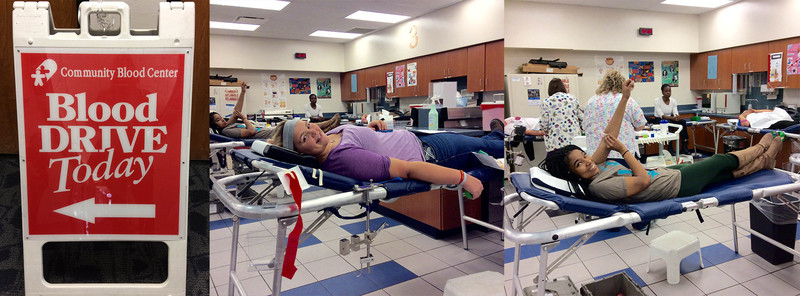HOSA Blood Drive Shared by Community Blood Center

ENGLEWOOD, Ohio - Students at Miami Valley Career Technology Center take pride in wearing a Red Cord with their graduation gown to show how often they supported blood drives. Now a new source of pride comes from wearing a bright red “Be Fit to Donate - Iron Up” wrist band to help classmates who want to give blood, but are turned away.
MVCTC received a $1,000 Community Blood Center High School Leadership grant for “Red Cord Excellence,” an indicator of strong student support at multiple blood drives. The class of 2015 had 96 graduates who qualified for the CBC Red Cord Honor Program by registering to donate at least three times during their high school career.
In 2014-15 MVCTC hosted two CBC blood drives and was the top Red Cord Honor School among the 118 high schools in CBC’s 15-county service area. MVCTC hosted its first blood drive of the 2015-16 school year Tuesday, Nov. 24.
Students strongly supported the blood drive with 151 registrations to donate, including 68 first-time donors and 109 blood donations.
MVCTC was awarded the grant money in September and immediately put some of it to work with the “Be Fit to Donate – Iron Up’ project. “Part of our Red Cord grant paid for that,” said blood drive coordinator Paula Wathen as she showed the red wrist band. “We have Med Lab students who are doing a study on how to decrease hemoglobin deferrals in girls.”
About 10 percent of potential donors are not allowed to donate because they don’t meet hemoglobin requirements. The percentage is often higher at high school blood drives. Of the 151 students who registered to donate at Tuesday’s blood drive, 37 were deferred.
CBC tests a drop of blood during donor screening to measure hemoglobin, a protein in red blood cells that contains iron and transports oxygen. It helps determine if a donor can afford to give away some of their red blood cells in a blood donation.
Seniors Jessica Kimball and Bethany Sommer are both Health Career Academy Med Lab students working on the hemoglobin study for the annual high school science fair. Low hemoglobin deferrals are most common among females at high school blood drives.
“I like this idea because I couldn’t donate myself,” said Jessica. “It means you feel upset, like you really wanted to do something good, but are disappointed about it. You can’t help people and you feel guilty about it.”
“A lot of females complained about not being able to donate because of hemoglobin levels,” said Bethany. They started the project by recruiting a group of about 60 girls. “They had to want to donate at both blood drives (the Nov. 24 blood drive and the Jan. 29, 2016 blood drive) and we tested them before the blood drive.”
The students drew blood samples from females taking part in the study and tested them using the Med Lab’s new blood analysis machine. The same girls registered for Tuesday’s blood drive and went through CBC’s screening tests. The students who tested low will go on a diet designed to increase their hemoglobin. “Iron-rich foods and foods that help absorb iron,” said Wathen. “And also, avoiding foods, like calcium-rich foods, that inhibit the absorption of iron.”
The girls will undergo more hemoglobin tests in the Med Lab to watch for improvement, and the final test will be when they try to donate two months from now at the Jan. 29 blood drive.
The hope is that they can share the satisfaction of donors like Rebecca Wolf, who made her second lifetime donation Tuesday. “I think when it comes to donating, most of us are in Allied Health or Biotech and we want to help save lives. Others just want to be great people, and I love that.”
Hayley Roberts made her 4th lifetime donation, and was surprised to learn she had already earned a Red Cord. “I thought it was four!” she said. “I like the thought of helping people and helping save lives.”
Perhaps the most satisfying donation belonged to senior Allied Health student Abbi Leet, who was able to pass hemoglobin screening and make her first lifetime donation. “I didn’t do it last year and I wanted to,” she said. “My mother was a phlebotomist and she believed in donating blood. She passed away when I was nine. I’m doing it for her.”
Learn more at www.GivingBlood.org
Connect with Community Blood Center for the latest information and services at www.GivingBlood.org. Get fast and complete answers on how to make your first donation, organize a blood drive, or bring our education program to your school. Get all the updates in the CBC/CTS newsroom, find quick links to our social media pages, or schedule your next appointment to donate by connecting to www.DonorTime.com.
Blood donation requirements: Donors are required to provide a photo ID that includes their full name. Past CBC donors are also asked to bring their CBC donor ID card. Donors must be at least 16 years of age (16 years old with parental consent: form available at www.givingblood.org or at CBC branch & blood drive locations), weigh a minimum of 110 pounds, and be in good physical health. The Food and Drug Administration (FDA) changes blood donor eligibility guidelines periodically. Individuals with eligibility questions are invited to email canidonate@cbccts.org or call 1(800)388-GIVE. Make an appointment at www.DonorTime.com.
Community Blood Center/Community Tissue Services® is an independent, not-for-profit organization. Community Blood Center provides blood products to 24 hospitals within a 15-county service area in the Miami (Ohio) and Whitewater (Indiana) Valleys. For more information about Community Blood Center/Community Tissue Services®, visit www.givingblood.org.
###









